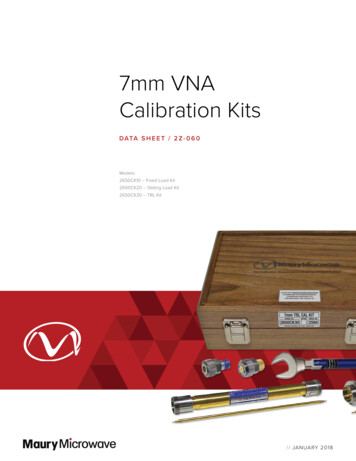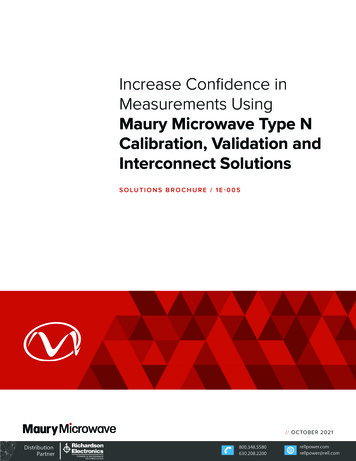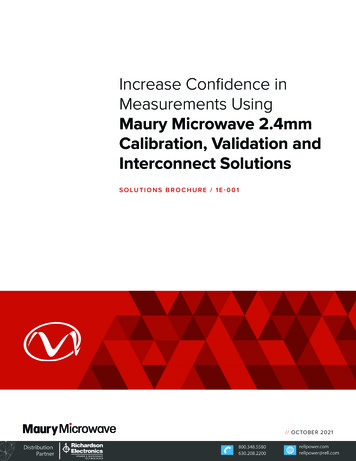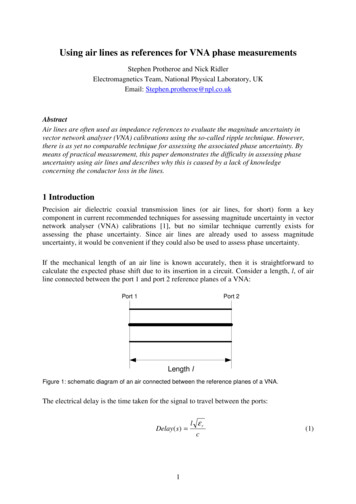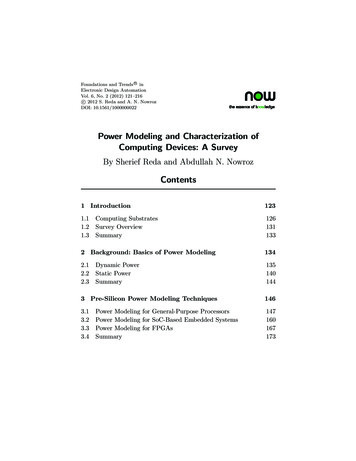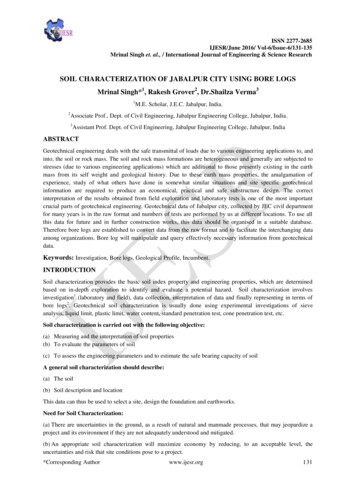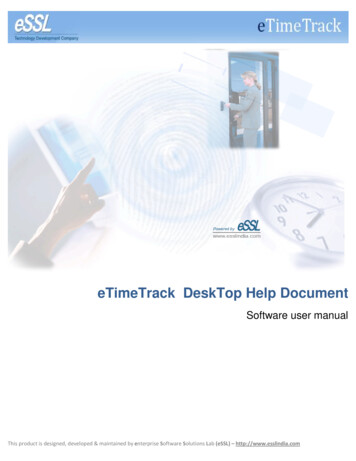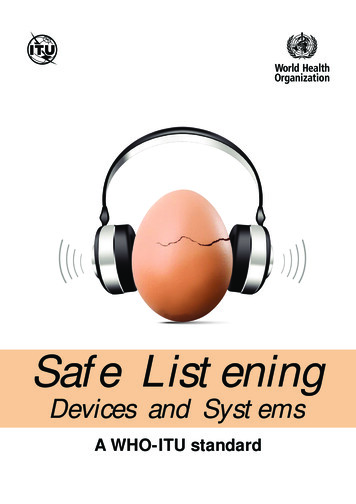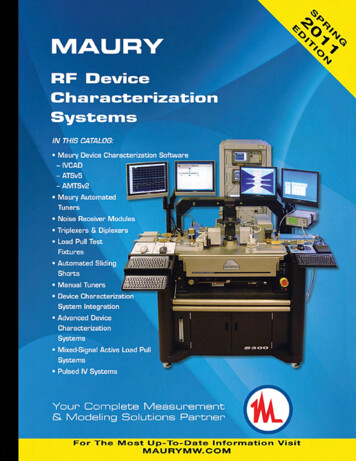
Transcription
RF Device Characterization SystemsMaury Device C naracterization SystemsMaury Microwave Has the Most Complete Selection of Load Pull Solutions!We Are Your Complete Measurement & Modeling Solutions Partner!In This Volume:RF Device Characterization MethodsAccurate de-embedded performance evaluation of the power, intermodulationdistortion, adjacent channel power, noise and network (S-parameter)characteristics of packaged or on-wafer devices under various conditions ofimpedance matching is the foundation of successful design, manufacture,and use of RF and microwave devices. Maury device characterization systemssupport the best industry-recognized test and measurement methods.Pitfalls To Avoid When Purchasing A DeviceCharacterization SystemAn automated device characterization system can greatly simplify test andmeasurement operations and quickly provide reliable empirically-based datafor design and modeling of new products. But finding the right system is notsimple. There are mistakes to be avoided if you are to maximize return oninvestment, achieve your test and measurement goals, and get your productsto market. Here is some valuable advice from the experts at Maury.Device Characterization Software (IVCAD, ATSv5and AMTSv2)Maury IVCAD software is the newest and most advanced measurement andmodeling software in the market. It supports multiple load pull techniques,performs noise parameter, DC-IV and pulsed-IV measurements, andincorporates sophisticated device modeling tools. Maury's ATS software(ATSv5) includes a comprehensive set of upgrades, improvements, andadditions to the classic ATS test and measurement tools.Maury's Automated Mobile Test System software (AMTSv2) is designedspecifically to automate the testing of mobile phones in transmit and receivemodes, for output power and sensitivity. It now includes support for GSM,WCDMA and CDMA2000.Load Pull and Noise Parameter SystemsMaury offers fully integrated, automated tuner-based systems configuredto operate from 0.25 to110 GHz. These complete turnkey systems can becustomized to support Basic (power, gain and PAE) and Advanced LoadPull characterization (modulation, optimal ACPR, COP, and Harmonic LP).Maury Noise Parameter systems are available in electromechanical and solidstate versions that can be customized to perform on-wafer or in-fixture noiseparameter characterization at frequencies from 0.25 to 110 GI-Iz.Tuners, Controllers And HubsMaury USB-controlled automated tuners and hubs are described in detail,with their respective specifications and applications.AccessoriesMaury offers a number of accessories to support your test bench needs,including automated tuner controllers, noise receiver modules, diplexers andtriplexers, pre-matching probe mounts, manual tuners, and automated slidingshorts.Advanced Device Characterization SystemsMaury now otters Mixed-Signal Active Load Pull systems, and the AMCADEngineering PIV/PLP family of Pulsed IV systems.MAURY MICROWAVE CORPORATION1RF Device Characterization Systems
SystiarnsYou Have Load Pull Needs - Have You Covered!Maury Microwave Has the Most Complete Selection of Load Pull SolutionsrL ser.40 *13 —a Niiii-2SNMAURY's Mixed-Signal ActiveLoad Pull Allows WidebandModulated Impedance Controlfor Base Station PAsActive and Hybrid Load PullUsing PNA-X SimplifiesHarmonic Tuning withGamma 1Pulsed-Bias Pulsed-RFHarmonic Load Pullfor GaN and Wide Band-GapDevicesUltra-Fast Noise ParameterMethod Gives More AccurateResults in Less Than 1/100ththe Time to 110 GHz!Stability and ConformanceTesting of Mobile Phones forGSM, CDMA, WCDMA./- IX-Parameter Modeling forFirst-Pass Advanced AmplifierDesign at over 200W10.„,;lir"Advanced Integration ofOn-Wafer Load Pull and NoiseParameters to 110 GHzUSB and TCP-1P Tuners forDo-lt-Yourself ProgramingUsing DLL or Direct ASCIICommandsThe Most Accurate andRepeatable Manual Tuners forSimple Tuning RequirementsMaury Microwave - Your Complete Measurement & Modeling Solutions PartnerOn the Web at MAURYMW.0011/1MAURYMICRO WAVEcon p, c,R AT ion,2900 Inland Empire Blvd., Ontario, California 91764 USATel: 909-987-4715 Fax: 909-987-1112 Email: maury@maurymw.comAgilent TechnologiesPort :r
.RF Device Characterization SystemisContentsMaury Device Characterization SolutionsModel IndexAMTSv2 Automated Mobile Test System Software4-5 Introductory InformationPitfalls to Avoid When PurchasingAn Automated Tuner SystemGeneral InformationAbout Maury MicrowaveMaury's Strategic AlliancesMaury Microwave's ISO 9001:2008 DocumentationCalibration and Repair ServicesMaury Automated Tuner SystemsRF Device Characterization Methods6-7891011121314-15General InformationHigh-Gamma Automated Tuners (HGT" 1High-Power Automated Tuners7mm Automated Tuners3.5mm Automated Tuners2.4mm Automated TunersMillimeter-Wave Automated TunersMulti-Harmonic Automated TunersIVCAD Advanced Measurement & Modeling SoftwareMT930 Series - IVCAD Software Suite OverviewMT930A - IVCAD Basic ApplicationMT930B - IVCAD Visualization SuiteMT930C - IVCAD Vector-Receiver Load PullMT930D - IVCAD Traditional Load PullMT930E - IVCAD IV Curves for Load PullMT930F - IVCAD Basic S-ParametersMT930G - IVCAD Time-Domain WaveformsMT930H - IVCAD Active Load PullMT930J - IVCAD Pulsed IV CurvesMT930K - IVCAD Pulsed S-ParametersMT930L - IVCAD Scripting LanguageMT930M1 - IVCAD Linear Model Extractiontv1T930M2 - IVCAD Non-linear Model ExtractionMT930M3 - IVCAD Electro-thermal Model ExtractionMT993N - IVCAD Database AnalysisMT930P - IVCAD Measurement Toolbox16171718-1920202121222323232425262616 o 3940424446485052AccessoriesAutomated Sliding ShortsAutomated Sliding Shorts - MT999 Series54Pre-Matching Probe MountsPre-matching Probe Mounts - MT902A Series56Noise Receiver ModulesSeries Noise Receiver Modules - MT7553 Series58Triplexers & DiplexersPrecision Low Loss Coaxial Triplexers - 9677( ) SeriesPrecision Low Loss Coaxial Diplexers - 9677D Series6061Load Pull Test FixturesMT964 Series Low-loss Test Fixtures for PowerApplications62Manual TunersATSv5 Automated Tuner System Software iv11- 993 Series SNPW - ATSv5 Automated Tuner System 3738383838Automated TunersSoftware Solutions o oMT910 Series - Automated Mobile Phone TestingMT910 - Mobile Phone TesterMT910A - GSM StandardMT910B - WCDMA StandardMT910C - CDMA2000 StandardSoftware Overview27MT993A - Power Characterization Application Software 28Noise Characterization Application Software30MT993B01 - Ultra-Fast Noise ParameterMeasurement Option31MT993C - Combines MT993A and MT993B27-28. 30MT993D - Intermod Distortion (IMD), Adjacent ChannelPower (ACP), and Error Vector Magnitude (EVM)32MT993D03 - Enhanced Time-Domain and X-ParametersLoad Pull Application Software33MT993D04 - Active Load Pull34MT993E - Programmers Edition36MT993F - System Control Option35MT993G - DC IV Curve Option35MT993N - Harmonic Source/Load Pull Option (SupportsTriplexer/Diplexer and Cascaded Tuner Techniques)35MT993J - Fixture Characterization Option35MT993N06 - Tuner Characterization Option20MT993V01 - Tuner Interpolation DLL Option36MT993VO4 - Tuner Movement DLL Option36MT993R - Tuner Automation Environment36tv1T993 DLL Library36General Information64Coaxial Stub Tuners65Coaxial Slide Screw Tuners- Wide Matching Range66Coaxial Slide Screw Tuners- Standard Matching Range68Waveguide Slide Screw Tuners- Standard Matching Range69Advanced Device Characterization SystemsRF Device Characterization Systems IntegrationIntegrated Load Pull and Noise Measurement Systems7071Mixed-Signal Active Load Pull Systemso MT2000 Series Mixed-Signal Active Load Pull Systems . 72Pulsed IV Systems AMCAD Engineering's PIV/PLP Systems Family75-79 CrMAURY MICROWAVE CORPORATION3RF Device Characterization Systems
RF Dev - Characterization SystemsModel IndexSOFTWARE PRODUCTSMT910AMTSv2 - Automated Mobile Phone Testerti1T910AAMTSv2 - GSM StandardAUTOMATEDTUNERS37-38ii11975AMillimeter Wave Automated Tuner (33-50 Gilt)39, 40-4138MT977AMillimeter Wave Automated Tuner (50-75 GHz)39, 42-4339, 44.45MT910BAMTSv2 - WCDMA Standard38MT978AMillimeter Wave Automated Tuner (60-90 GHz)MT910CAMTSv2 - CD61A2000 Standard38MT979AMillimeter Wave Automated TunerMT981AU11 High-Power Automated Tuner (0.25-2.5 Gift)39, 42-43MT930NCAD - Advanced Measurement & Modeling Software16ti1T981BUxx High-Power Automated Tuners39. 42-43MT930ANCAD - Basic Application17MT981BU10 High-Power Automated Tuner (0.4-4.0 GHz)39, 42-43MT930BNCAD - Visualization Suite17MT981BU15 High-Power Automated Tuner (0.4-2.5 GHz)39, 42-43MT9300(WAD - Vector-Receiver Load Pull18-19MT981BU16 High-Power Automated Tuner (0.4-2.5 GHz)39, 42-43MT930DIVCAD - Traditional Load Pull20MT981EU10 High-Power Automated Tuner (0.8-8.0 GHz)39, 42-43MT930ENCAD - IV Curves for Load Pull20PAT981HU13 High-Gamma v l Automated Tuner (0.8-8.0 GHz)39, 40-41MT930FNCAD - Basic S-Parameters21MT981HU23 High-Gamma TV Automated Tuner (0.8-8.0 GHz)39, 40-41MT930GNCAD - Time-Domain Waveforms21MT981HU33 High-Gamma TV Automated Tuner (0.8-8.0 GHz)39, 40-41MT930t1NCAD - Active Load Pull22fr1T981Htlxx High-Gamma TM Automated Tuners (HGT"il)39, 40-4139, 46.47MT930JNCAD - Pulsed R! Curves23MI98151/(110 High-Power Automated Tuner (0.4-2.5 GHz)39, 42-43MT930KIVCAX - Pulsed S-Parameters23MT982AUO2 7mm Automated Tuner (1.8-18.0 GHz)39, 44-45MT930LNCAD - Scripting Language23MT982BUO1 7mm Automated Tuner (0.8-18.0 GHz)39, 44.45MT930M1NCAD - Linear Model ExtractionMT982EU7mm Automated Tuner (0.8-8.0 GHz)39, 44-4524MT930M2NCAD - Non-linear Model Extraction24PAT982EU30 7mm Automated Tuner (0.8-8.0 GHz)39, 44-45MT930 M3(CAD - Electro-thermal Model Extraction26MT982xU7mm Automated Tuners39, 44-45MT930NNCAD - Database Analysis26tilT983A013.5mm Automated Tuner (4-26.5 GHz)39, 46.47MT930PNCAD - Measurement ToolboxMT993ATSv5 Automated Tuner System SoftwareMT993AATSv5 Power Measurement SoftwareMT993BATSv5 Noise Parameter Measurement Software30MT993B01ATSv5 - Ultra-Fast Noise ParameterMeasurement Option3116MT984AU01 2.4mm Automated Tuner (8-50 GHz)MT982M01MT993CATSv5 - Power & Noise Software SuiteMt993DATSv5 - IMD, ACP and EVM OptionMT993D03ATSv5 - Entranced Time-Domain & X-ParameterLoad Pull OptionfAT993D04ATSv5 - Active Load PullMT993EATSv5 - Programmers EditionMulti-Harmonic Automated Tuner (600 MHz -26 GHz)39, 48.5039.52-5327MANUAL TUNERS; STUB TUNERS28-291719ACoaxial Double-Stub Tuner (SMA 0.4-1 GHz)6517196Coaxial Double-Stub Tuner (SMA 0.8-4 GHz)6517190Coaxial Double-Stub Tuner (SMA 4-18 GHz)651778ACoaxial Double-Stub Tuner (Type N 0.4-1 GHz)6517788Coaxial Double-Stub Tuner (Type N 0.8-4 GHz)65331778CCoaxial Double-Stub Tuner (Type N 2-12 GHz)65341778DCoaxial Double-Stub Tuner (Type N 4-18 GHz)65361778ECoaxial Double-Stub Tuner (Type N 2-18 GHz)65Coaxial Double-Stub Tuner (Type N 0.2-0.5 GHz)6527, 28, 3032MT993FATSv5 - System Control Option351778GMT993GATSv5 - DC IV Curve Option351819ACoaxial Triple-Stub Tuner (SMA 0.4-1 GHz)65MT993HATSv5 - Harmonic Source/Load Pull Option3518198Coaxial Triple-Stub Tuner (SW 0.8-4 GHz)65MT993JATSv5 - Fixture Characterization Option3518190Coaxial Triple-Stub Tuner (SMA 2-18 Mit)65Coaxial Triple-Stub Tuner (SMA 4-18 GHz)65MT993N06ATSv5 - Tuner Characterization Option361819DMT993RATSv5 - Tuner Automation Environment361878ACoaxial Triple-Stub Tuner (Type N 0.4-1 GHz)65Coaxial Triple-Stub Tuner (Type N 0.8-4 GHz)65Coaxial Triple-Stub Tuner (Type N 2-12 GHz)65MT993401ATSv5 - Tuner Interpolation DLL Option3618788MT993VO4ATSv5 - Tuner Movement DLL Option361878CMAURY MICROWAVE CORPORATION4RF Device Characterization Systems
RF Device Characterization Systehiiii:MANUAL TUNERS; STUB TUNERS (continued)1878DCoaxial Triple-Stub Tuner (TypeN4-18 GHz)ACCESSORIES65MT7553Noise Receiver Module (10 MHz - 110 Gtiz)58-59Noise Receiver Module (10 MHz - 50 GHz)58-591878GCoaxial Triple-Stub Tuner (Type N 0.2-0.5 GHz)65MT7553B261281Coaxial Triple-Stub Tuner (7mm 0.4-1 Gtiz)65MT7553B01 Noise Receiver Module (10 MHz - 50 GHz)58-59MT7553M10 Noise Receiver Module (75-110 GHz)58-59261282Coaxial Triple-Stub Tuner (7mm 0.8-4 GHz)65261283Coaxial Triple-Stub Tuner (7mm 2-12 GHz)65MT7553M12 Noise Receiver Module (60-90 GHz)58-5958-59, 71261284Coaxial Triple-Stub Tuner (7mm 4-18 GHz)65MT7553M15 Noise Receiver Module (50-75 Gtiz)2612C1Coaxial Double-Stub Tuner (7mm 0.4-1 GHz)65MT964A17mm Load Pull Test Fixture (100 MHz - 18 Gtiz)62-633.5mm Load Pull Test Fixture (100 MHz - 18 GHz)62-632612C2Coaxial Double-Stub Tuner (7mm 0.8-4 GHz)65MT964A2261203Coaxial Double-Stub Tuner (7mm 2-18 Gtiz)65MT964B17mm Load Pull Test Fixture (800 MHz - 18 GHz)62-633.5mm Load Pull Test Fixture (800 MHz - 18 Gtiz)62-632612C4Coaxial Double-Stub Tuner (7mm 4-18 Gtiz)65MT964B22612C7Coaxial Double-Stub Tuner (7mm 0.2-0.5 GHz)65MT986AATS Tuner Controller (GPIB)36t,1T986BATS Tuner Controller (GPIB)36MANUAL TUNERS; COAXIAL SLIDE SCREW TUNERS36MT986CATS Tuner Controller (GPIB)MT10208ATS Power Distribution Hub36, 40-41, 42-43, 48-49MT1020CATS Power Distribution Hub36, 46-47, 51-52, 54-55MT1020DATS Desktop Switching Power SupplyMT902A1Basic Pre-Matching Probe Mount (DC-50 GHz))56-57MT902A2High-Freq. Pre-Matching Probe Mount (21.5-50 GHz)56-57MT902A3Low-Freq. Pre-Matching Probe Mount (8-21.5 GHz)56-57MT902A5Basic Pre-Matching Probe Mount (DC-50 GHz))56-57MT902A6High-Freq. Pre-Matching Probe Mount (21.5-50 GHz)56-57MT902A7Low-Freq. Pre-Matching Probe Mount (8-21.5 Gtiz)56-57MT999AAutomated Sliding Short (0.8-7.5 GHz)54-5554-551643CCoaxial Slide Screw Tuner (Type N 0.9-12.4 GHz)681643DCoaxial Slide Screw Tuner (Type N 1.8-18 Gtiz)681643D1Coaxial Slide Screw Tuner (Type N 1.8-18 GHz)661643NCoaxial Slide Screw Tuner (Type N 0.8-8 GHz)661643PCoaxial Slide Screw Tuner (Type N 0.8-18 GHz)6624408Coaxial Slide Screw Tuner (14mm 0.8-8 Gtiz)662440CCoaxial Slide Screw Tuner (14mm 0.4-4 GHz)662640CCoaxial Slide Screw Tuner (7mm 0.9-12.4 GHz)682640DCoaxial Slide Screw Tuner (7mm 1.8-18 GHz)682640D1Coaxial Slide Screw Tuner (7mm 1.8-18 Gtiz)662640NCoaxial Slide Screw Tuner 7mm 0.8-8 GHz)662640PCoaxial Slide Screw Tuner (7mm 0.8-18 GHz)6627408Coaxial Slide Screw Tuner (7-16 0.8-8 GHz)662740CCoaxial Slide Screw Tuner (7-16 0.4-4 Gtiz)667941ACoaxial Slide Screw Tuner (2.4mm 12-50 GI-1z)6680418Coaxial Slide Screw Tuner (3.5mm 12-26.5 GHz)68MT9008041 CCoaxial Slide Screw Tuner (3.5mm 12-34 GHz)66ADVANCED RF DEVICE CHARACTERIZATION SYSTEMS8045CCoaxial Slide Screw Tuner (3.5mm 0.9-12.4 GHz)688045DCoaxial Slide Screw Tuner (3.5mm 1.8-18 GHz)688045D1Coaxial Slide Screw Tuner (3.5mm 1.8-18 Gtiz)668045NCoaxial Slide Screw Tuner (3.5mm 0.8-8 GHz)668045PCoaxial Slide Screw Tuner (3.5mm 0.8-18 Gtiz)6640-41, 42-43, 48-49MT999BAutomated Sliding Short (3.0-18 GHz)9677xPrecision Low Loss Coaxial Triplexers609677DxxPrecision Low Loss Coaxial Diplexers61RF DEVICE CHARACTERIZATION SYSTEM INTEGRATIONProbe Station Integration70MT2000AMixed-Signal Active Load Pull System (400 MHz - 18 GHz) . 72-74MT2000BMixed-Signal Active Load Pull System (400 MHz - 18 GHz) . 72-74MT2000CMixed-Signal Active Load Pull System (1 - 26 GHz)72-74MT2000DMixed-Signal Active Load Pull System (1 - 26 GHz)72-74AMCAD ENGINEERING PULSED IV SYSTEMSMANUAL TUNERS; WAVEGUIDE SLIDE SCREW TUNERSX353Waveguide Slide Screw Tuner (ViR90 8.2-12.4 Gtiz)69X353Waveguide Slide Screw Tuner (V/R62 12.5-18 GHz)69X353Waveguide Slide Screw Tuner (V/R42 18-26.5 GHz)69X353Waveguide Slide Screw Tuner (V/R28 26.5-40 GHz)69X353Waveguide Slide Screw Tuner (V/R22 33-50 Gtiz)69MAURY MICROWAVE CORPORATION5PIVAMCAD Pulsed IV Systems75-79PLPAMCAD Pulsed IV Systems75-79RF Device Characterization Systems
ev cieCI; aracter zSyStioniii- Pitfalls 'o Avoid When PurchasingAthomated Tuner SystemWhat Really Matters in Choosinga Tuner-Based Measurement andCharacterization System?Pitfall #2.Avoid choosing a tuner-based system that lacks sufficientimpedance range and distribution.Impedance range, often called matching range or mismatchrange, refers to the impedance range a tuner can present. Thisis a critical characteristic for high-power applications, wheresub 1 ohm impedances are often encountered. Impedancedistribution refers to coverage of impedance points over theSmith chart and the distribution of those points within thatregion.How do you choose between the various passive solid-state andpassive-mechanical systems on the market today. What aboutactive-injection systems? What really matters in choosing anautomated tuner system?The answer depends on your application requirements andmeasurement goals. Tuner characteristics are very important,but their relative priority depends on how well specifictuner attributes meet the needs of your measurement andcharacterization applications. For example, while passivemechanical tuner systems can be used for both noise andpower characterization, a passive solid-state system - due toits smaller module size and higher-speeds - might be a betterchoice for high speed on-water lot-tracking of low-noise CMOSprocesses. Similarly, a passive-mechanical tuner system isnecessary for very high power applications, roughly anythingover 1 ohm or so. Active-injection systems are primarily foundin mm-wave applications where cabling and wafer-probe lossesare high.Pitfall #3.Avoid choosing a tuner-based system with slow tuning speed.Tuning speed refers to the time it takes a tuner to move fromone impedance state to the next. This is a critical characteristicwhen making measurements, such as collecting lot-trackingdata for a low-noise process. Total measurement time, at eachimpedance, is a function of measurement equipment and thetype of measurements being made, plus the inherent tuningspeed.Assuming you know which system architecture best meets yourneeds, what distinguishes one manufacturer's products fromanother's? What are the pitfalls to look out for when choosing asystem?Pitfall #4.Avoid choosing a tuner-based system with insufficient powercapability.Power capability refers to both the maximum rms and peakpower that can be delivered to a tuner without any appreciablechange in tuner impedance or any damage to the tuner. A hightuner insertion loss results in heating of tuner elements, whichcan perturb the calibrated impedance seen by the deviceunder-test (DUT). An improperly designed tuner, along withcertain classes of RF connectors, can exhibit corona dischargeor arcing, resulting in damage to the tuner or the DUT.Pitfall #1.Avoid choosing a tuner-based system that doesn't score highon repeatability.Because passive tuner-based systems rely on a prioricharacterization of tuner impedances, the ability to repeattuner impedance states is critically important in ensuringthe accuracy and meaningfulness of device characterizationdata. Use of inaccurate impedance data in matching networksynthesis or model verification will lead to differencesin measured or simulated performance with respect toperformance reported by the automated tuner system. A goodsystem, like the Maury passive-mechanical tuner systems inthis catalog, typically exhibit better than -60 dB and -70 dBrepeatability to 50 GHz. Since this exceeds VNA calibrationuncertainty by a wide margin, Maury's automated tuners areessentially transparent in terms of repeatability.Pitfall #5.Avoid choosing a tuner-based system with insufficientresolution.Tuner resolution refers to the number of impedance points thatcan be synthesized by the tuner. Solid-state tuner systems areusually composed of two individual cascaded tuners, each witha few hundred points, resulting in over 500,000 tuning points.Passive-mechanical tuner systems typically exhibit 10,000points using one tuner. This can be expanded to millions ofpoints using cascaded tuners or interpolation.When considering a tuner's repeatability, don't be fooledby "creative" specifications. Maury tuner repeatability isdetermined by measuring the actual "worst case" error betweenany two measurements at the same impedance positionfor more than 13,000 impedance positions over the entirefrequency range and full matching range of the tuner. Comparethat to other manufacturers who advertise the "average"repeatability of their tuners. Any tuner's average repeatabilityerror vector can be made to look better than its worst case errorvector. Relying on the average can provide a misleading, andinaccurate picture of the tuner's performance.MAURY MICROWAVE CORPORATIONHow much resolution is enough? It depends. Consider a typicaltransistor used as a final-stage for a 3.2 V GSM PA. The loadimpedance needed for this transistor to deliver 35 dl3m is about2 ohms. Normal manufacturing targets for supply voltage changeover battery charge-time require an impedance resolution, DIG',of about 0.009. Even in the extreme case of uniform coveragein the gamma-domain, this tuning resolution requires only50,000 impedance states, which can easily be achieved usingMaury passive solid-state or passive-mechanical tuners.6RF Device Characterization Systems
%.Pitfall #6.situ calibration is normally used, and acoustic vibrations maybe a concern. Most passive-mechanical tuners require specialmounting plates, and/or probe extensions to accommodate theirphysical dimensions.Avoid choosing a tuner-based system with insufficientbandwidth.Tuner bandwidth usually refers both to the frequency range ofthe tuner and to its instantaneous bandwidth. Tuner frequencyrange refers to the bandwidth over which the tuner is ableto present its specified impedances. Both passive solid-stateand passive-mechanical usually exhibit at least a decadeof operating range. Instantaneous bandwidth refers to themodulation envelope within which impedance remainsconstant. This is an important parameter for widebandmodulation formats such as WCDMA.Pitfall #8.Avoid choosing a tuner-based system whose manufactureroffers insufficient after-sale support.After-sale support is as critical in the device characterizationfield as it is anywhere. Unfortunately, not all manufacturers areas prepared, or as good, at supporting their products as theyare at selling them. Low price always seems good at the timeof purchase, but may be hiding a high cost to be paid in timelost while waiting for support. Be sure to satisfy yourself that thecompany behind your tuner-based system has the commitmentto customer support that you are entitled to.Maury passive-mechanical tuners are based on a slabtransmission line loaded by a pair of shunt sliding-shorts, orprobes. A precision stepper motor controls the distance of theprobes from the center conductor, and another stepper motorcontrols distance of the probe assembly from the load. Oneprobe operates at the low end of the tuner's frequency range,and the other at the upper end. The paired probes provideoverlapping high and low coverage to increase the tuner'soperating bandwidth to over a decade. The physical resolutionof the probe assembly coupled with advanced interpolationalgorithms, enable users to synthesize millions of impedancepoints across the tuner's full bandwidth.ConclusionThe factors impacting your choice of tuner-based measurementsystems are mostly determined by the requirements of yourapplications. Once you know what system architecture bestsuits your needs, choosing the right tuner system depends agreat deal on what you know about who makes it and howthey address the issues of bandwidth, repeatability, tuner speed,impedance range and distribution, power capability, andtuner size and ease of integration. No two systems are exactlyalike, because the applications they serve are almost alwaysunique. Hopefully, the information in this article will help youin making what is always a complicated choice. When you'reready, Maury's team of system integration specialists is here tohelp you build a device characterization system that is tailoredto your needs an that will provide you with the highest level ofPitfall #7.Don't overlook the importance of tuner size and case ofintegration.Tuner size can be very important in certain applications, as isthe potential difficulty or complexity of their integration intoa test setup. These factors are more often a concern when thesetup is on a probe station and the application(s) are to bedone on-wafer and at high speed. In such an environment, inMAURY MICROWAVE CORPORATION RP Device Characterization SystemsConfidence in Measurement.7RF Device Characterization Systems
Device CharSeterizatIon SystemsGeneral [InformationHowToOrder Maury ProductsOrders may be placed directly with the factory or in care of yournearest Maury sales representative. For orders originating outsidethe United States, we recommend placing the order through yourlocal Maury sales representative. Maury maintains an extensivenetwork of sales representatives throughout the world. To findyour local Maury sales representative use the interactive indexon our web site at maurymw.com/srx.htm.Pricing and QuotationsPrices for Maury products are those prevailing when an order isplaced except when the price is established by formal quotation.Maury Microwave reserves the right to change prices at any timewithout notice. Price and availability of products with customor special features must be verified by a valid, formal factoryquotation. Maury quotations are valid for a maximum of 30 days.Extensions beyond 30 days can be granted only by the factory.Terms of SaleDomestic terms are net 30 clays from the date of invoice forcustomers with established credit F.O.B. Ontario, California.Please refer to Maury Form 228 for complete terms andconditions. For International sales, please refer to Maury Form250. Sales to Canada are covered by Maury Form 251. Theseforms are available on request, or may be found on our web sitein PDF format.ShipmentAll shipments are at the buyer's expense. Shipments are normallymade using methods and carriers specified by the customer.In the absence of specific instructions, Maury will ship at ourdiscretion by the most advantageous method. All shipments areF.O.B. the Maury factory in Ontario, California (U.S.A.) and,unless otherwise specified, will be insured at full value at thecustomer's expense. Shipments are packed to provide amplesafety margin against transit damage, and there is no charge forregular packing requirements. Additional charges apply to MILSPEC preservation, packaging, packing and marking.Product and Specifications ChangesThe information, illustrations and specifications containedin this catalog were current at the time of publication. MauryMicrowave is continually striving to upgrade and improve ourproduct offering and therefore, reserves the right to changespecifications, designs and models without notice and withoutincurring any obligation to incorporate new features on productspreviously sold.Because products are changed or improved with time,please consult your local Maury representative, or our SalesDepartment, for current pricing and product information beforeplacing orders.Product SelectionMaury representatives and sales office personnel are wellqualified to provide assistance in product selection, and currentpricing and availability. Our factory applications engineers areready to assist you with any technical or applications questionsyou may have.MAURY MICROWAVE CORPORATIONService and SupportWarrantyMaury Microwave is highly confident that our products willperform to the high levels that our customers have come toexpect. As an expression of that confidence, our products arewarranted as noted in the abbreviated warranty statementsbelow. (For a complete statement of the hardware warranty,please see Form 228, Terms and Conditions of Sales. For acomplete statement of the software warranty, please see Form273, Maury License Agreement.)Maury Microwave hardware products are warranted againstdefects in material and workmanship for a period of one yearafter delivery to the original purchaser. If a Maury manufacturedhardware product is returned to the factory with transportationprepaid and it is determined by Maury that the product isdefective and under warranty, Maury will service the product,including repair or replacement of any defective parts thereof.This constitutes Maury's entire obligation under this warranty.Maury warrants that, for a period of ninety (90) days followingpurchase, software products, including firmware for usewith and properly installed on a Maury designated hardwareproduct, will operate substantially in accordance with publishedspecifications, and that the media on which the product issupplied is free from defects in material and workmanship.Maury's sole obligation under this warrant}, is to repair or replacea nonconforming product andor media, provided Maury isnotified of nonconformance during the warranty period. Maurydoes riot warrant that the operation of the product shall heuninterrupted or error-free, nor that the product will meet theneeds of your specific application.The warranty does not apply to defects arising from unauthorizedmodifications, misuse or improper maintenance of the product.Warranty service is available at our facility in Ontario, California.Service ReturnsRepair and calibration services are available for Maury productsfor as long as replacement parts are available. On sonicinstruments, support services may be available for up to tenyears.Quality ProfileMaury Microwave Corporation enjoys a well-earned reputationfor excellent, technically advanced products that are reliable,meet specifications, arid provide a quality appearance.Maintaining and improving this reputation requires adherenceto strict quality standards that are set forth in a formal QualityDepartment Manual. This manual is distributed to all Maurymanagers, inspectors, and technicians. The Quality Manualcan he reviewed by our customers at our facility in Ontario,California.Our inspection and calibration systems are in accord with MIL-I45208A and MIL-STD-45662A, respectively. Our overall qualitysystem has been approved through in-house surveys by many ofour customers including the U.S. Government. Our laboratory isANSI/NCSL Z540-1 compliant with tracea
Maury Microwave - Your Complete Measurement & Modeling Solutions Partner On the Web at MAURYMW.0011/1 2900 Inland Empire Blvd., Ontario, California 91764 USA Tel: 909-987-4715 Fax: 909-987-1112 Email: maury@maurymw.com Agilent Technologies Port :r.
